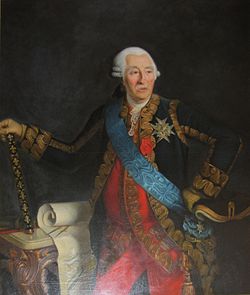You can help expand this article with text translated from the corresponding article in French. (May 2011)Click [show] for important translation instructions.
|

Anne Pierre d'Harcourt, 4th Duke of Harcourt was a French Royal Army officer and nobleman, notable as a duke of Harcourt and the fourth marshal of France from the House of Harcourt. He was the son of Henry d'Harcourt and great grandson of Abraham de Fabert, both marshals of France.
He was born on 2 April 1701, was made marshal of France on 24 March 1775 and died in 1784. [1]
He married Thérèse Eulalie de Beaupoil and had 5 children, including François-Henri d'Harcourt.
Anne Pierre d'Harcourt assumed the dukedom on the death of his brother. He became lieutenant-general of Upper Normandy in 1716 and was appointed governor of the same province on 15 June 1764. He was succeeded in the dukedom by his son, François-Henri. [2]